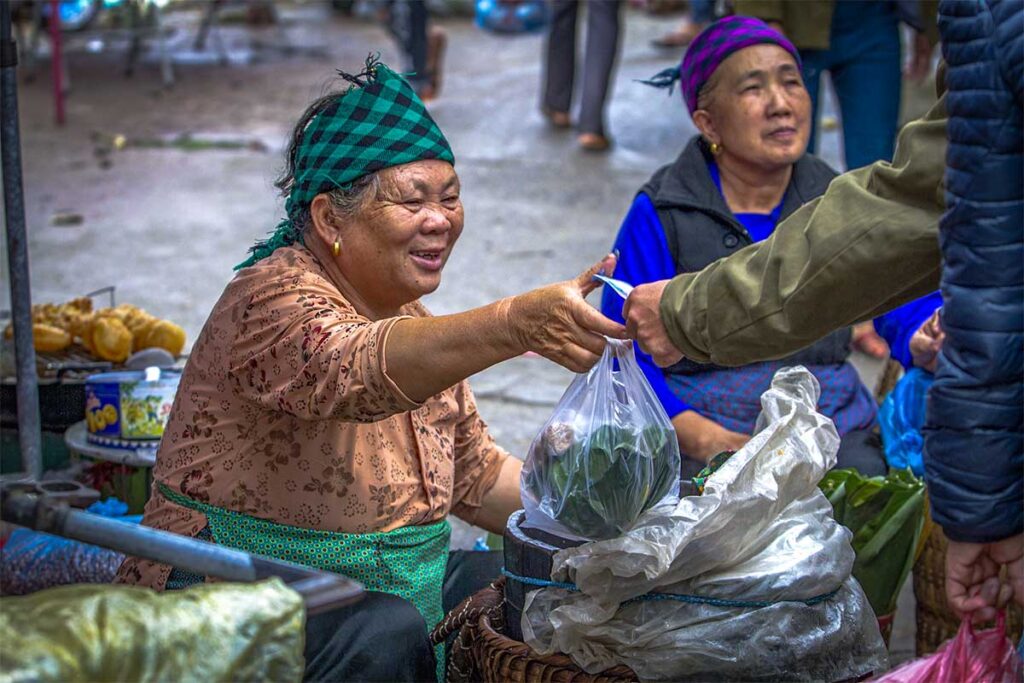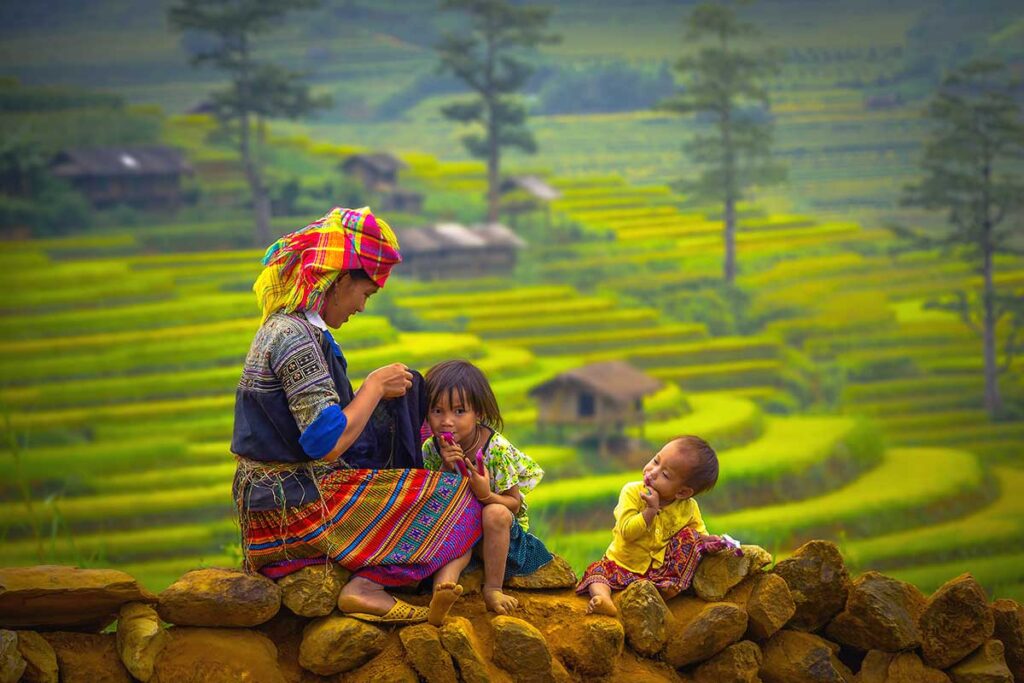What is Muong Khuong Market like?
Muong Khuong Market takes place in the center of Muong Khuong town, the district capital of this remote area near the Chinese border. It’s one of the largest markets in the region, drawing in a wide range of ethnic groups including the Hmong, Nung, Dao, Giay, Tay, Phu La, and even some Chinese traders from across the border.
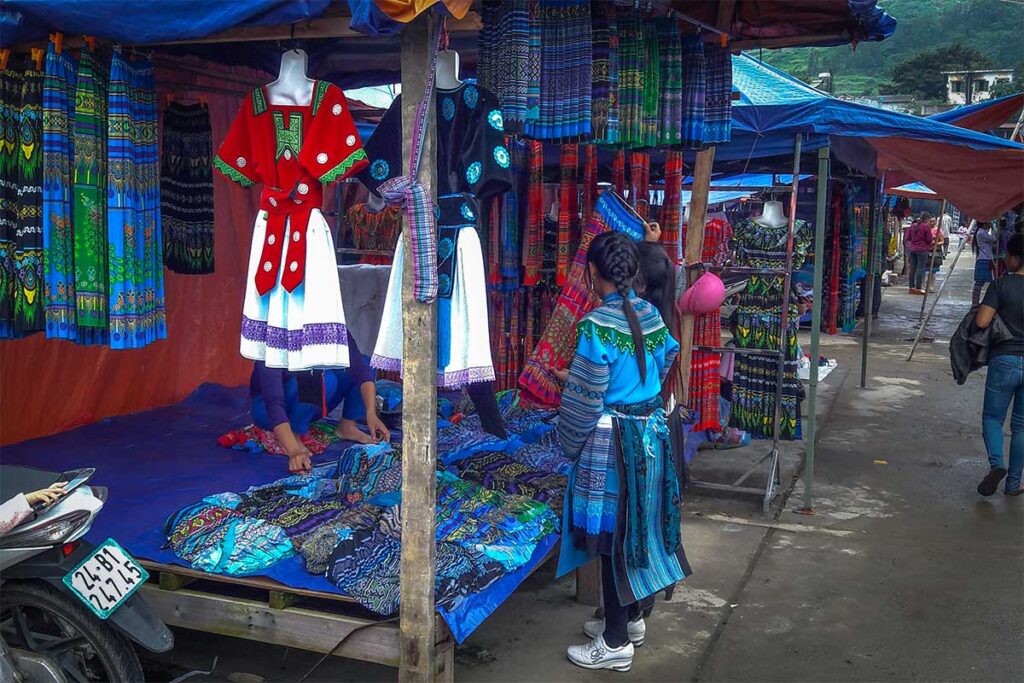
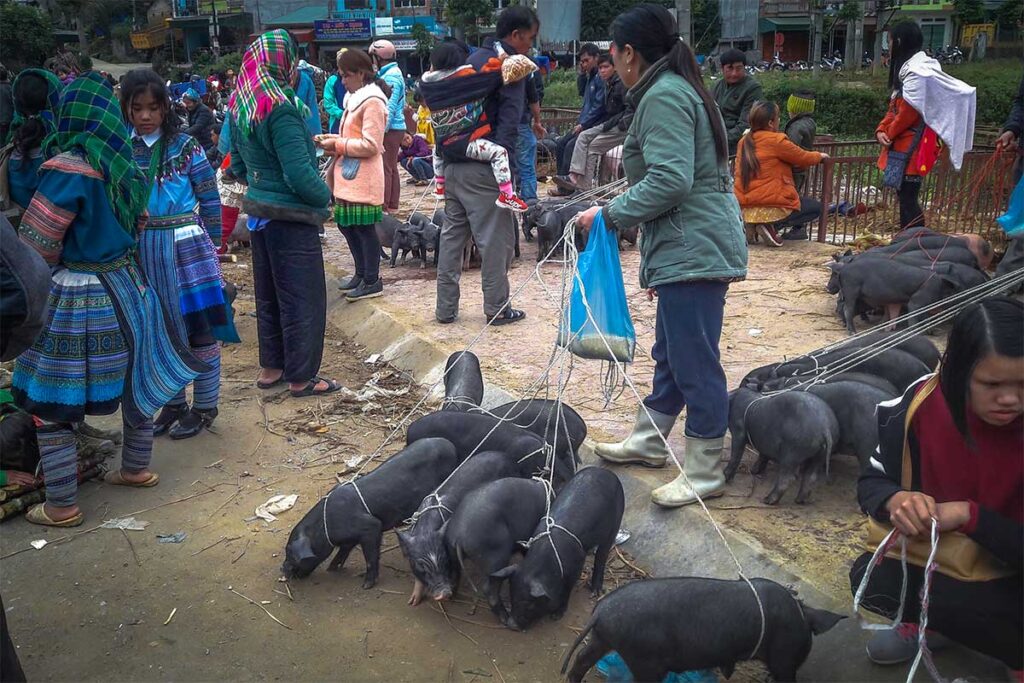
The market is divided into several lively zones — fresh produce, brocade textiles, household tools, Chinese consumer goods, pigs for sale, and a bustling street food section. While the market area has been newly developed and is more organized than some smaller village markets, it still feels authentic and local. There are hardly any tourist stalls or pressure to buy, and for the best experience, it’s worth arriving early in the morning when everything is in full swing.
When is Muong Khuong Market?
Muong Khuong Market is held every Sunday morning, with activity starting as early as 6:30 or 7:00 AM. By 11:00 AM, most stalls begin packing up, and the crowd starts to thin. It’s a Sunday-only event — there’s no market activity on other days. Locals from nearby villages arrive early, often by motorbike, foot, or truck, creating a lively and crowded atmosphere through the morning. If you want to see the market at its busiest and most colorful, early arrival is essential.
How to get to Muong Khuong Market
Muong Khuong Market is located in the far northeast of Lao Cai Province, not far from the Chinese border. Despite its remote location, the roads leading there are in relatively good condition, making it more accessible than some of the smaller commune markets nearby.
Location & Travel time
- From Sapa, it’s about 90 km to Muong Khuong — just over 2 hours by car.
- From Lao Cai City, the distance is shorter at 40–45 km and takes around 1.5 hours.
- The route is paved and easier to drive than the roads to markets in Muong Khuong District, like Lung Khau Nhin Market (Thursday) or Cao Son Market (Wednesday).
Private car
There are no public tours running to Muong Khuong, so the best option is to arrange a private car with driver. It’s a comfortable and flexible way to reach the market — especially if you want to arrive early and avoid the crowds.
Need a driver from Sapa or Lao Cai?
We offer private transfers to Muong Khuong and other local markets.
Motorbike
If you’re confident on a motorbike, the trip is doable and the roads are mostly paved. The scenery along the way is beautiful, but services are limited, so be sure to fuel up before you leave and bring some basic supplies.
What to see at Muong Khuong Market
Muong Khuong Market is large and diverse, with different sections offering a glimpse into local life, trade, and culture. It’s not polished or curated — just a real, functioning market where people come to buy, sell, eat, and socialize. Here’s what you’ll find across its different areas:
1. Traditional clothing & Brocade
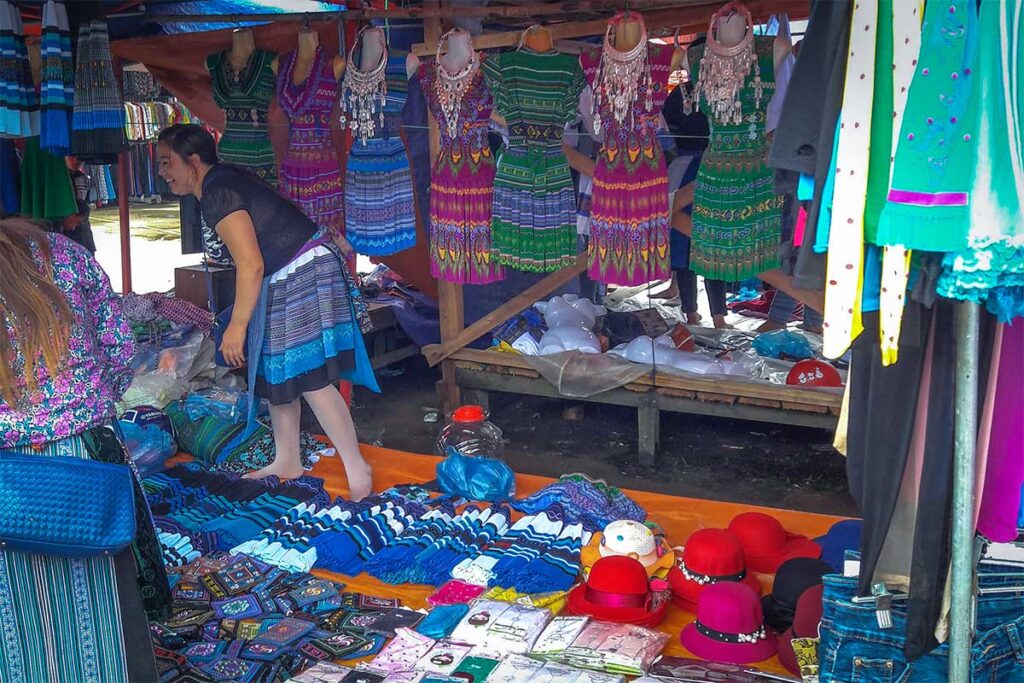
Many women arrive in their finest traditional outfits — especially from the Hmong, Nung, and Dao ethnic groups. You’ll see bright colors, elaborate embroidery, and a range of brocade items for sale, including skirts, scarves, and handmade bags. Some are for daily use, others more decorative, but all reflect the region’s cultural identity.
2. Chinese goods & Household items
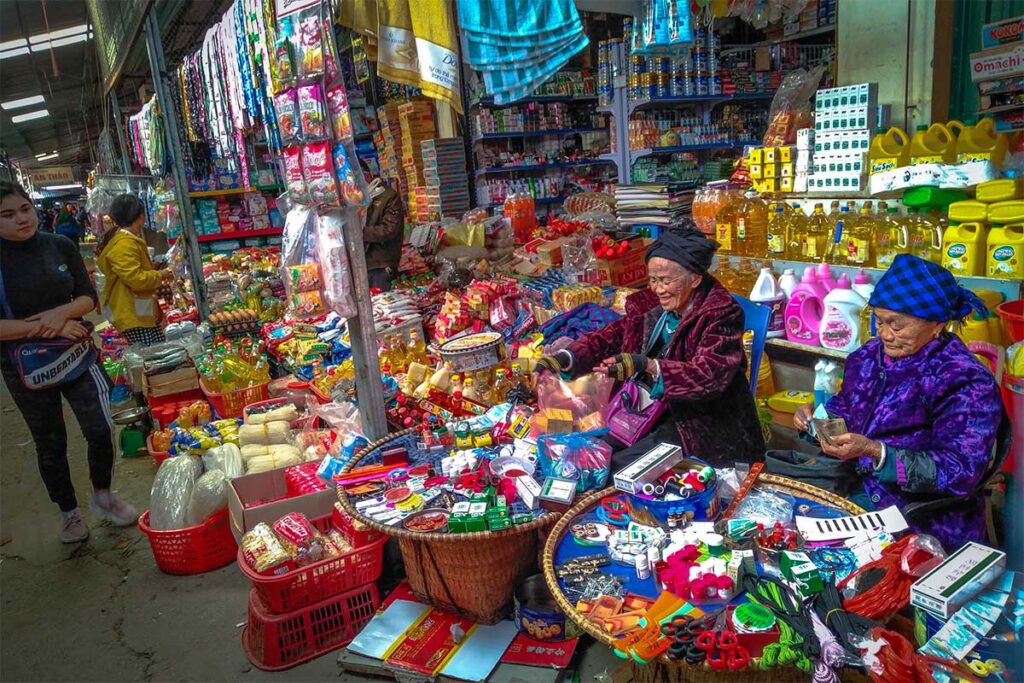
Being close to the border, the market includes many stalls selling cheap Chinese imports — from clothing and plastic goods to mobile accessories and kitchen tools. It’s not a place for crafts or artisan souvenirs, but an interesting look at what locals actually buy and use in daily life.
3. Fresh produce & Local products

The produce section is vibrant and seasonal: vegetables, fruits, herbs, and mountain products like star anise, tam thất root, and Muong Khuong’s famous tangerines. Local specialties like corn wine, chili sauce, cardamom, and dried goods are also widely sold — some are even worth bringing home.
4. Livestock section (Mostly Pigs)
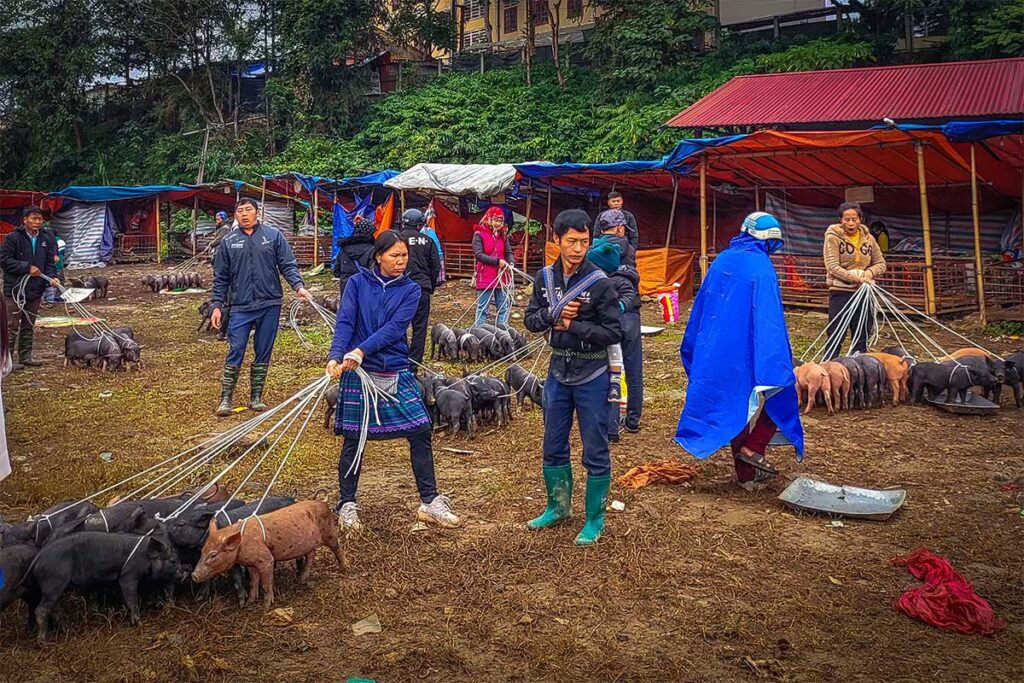
Instead of being penned up, pigs are usually led around on ropes like dogs — it’s a small but lively part of the market. You won’t find buffalo or cattle here, but for many locals, pigs are a key part of trade and rural life.
5. Food court area
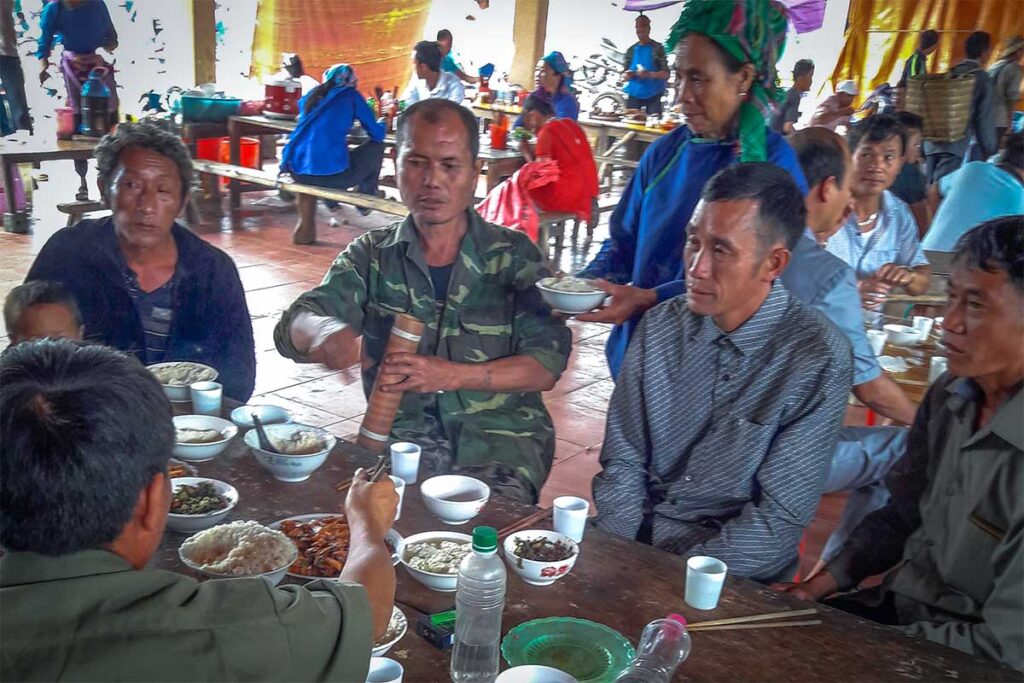
At the heart of the market is a street-food-style eating area where locas gather for early lunch or a quick breakfast. Expect noodle soups, sticky rice, grilled meats, and homemade corn wine passed around in small cups. There are no menus or translations — just point, smile, and join in.
Tips for visiting Muong Khuong Market
Visiting Muong Khuong Market is a great way to experience highland culture, but it helps to plan ahead. Here are a few practical tips to make your visit smoother:
- Arrive early – The market is at its most lively and colorful before 9:00 AM.
- Stay in Sapa or Lao Cai – There are no guesthouses or hotels in Muong Khuong town.
- Bring cash – No ATMs nearby, and vendors only accept Vietnamese dong.
- Dress modestly – Respectful clothing is appreciated in this traditional setting.
- Photography tip – People are generally open to photos, but always ask first for close-ups.
- Don’t expect souvenirs – Most goods are for local use; the value is in the experience.
- Prepare for the return drive – It’s a long round trip with little else to stop for along the way.
Is Muong Khuong Market worth visiting?
If you’re looking for a large, authentic ethnic market without tour groups or staged experiences, Muong Khuong Market is a strong choice. It’s lively, colorful, and full of genuine trade and interaction. The size and variety make it especially appealing for photographers and travelers who want to go beyond the typical tourist trail.
However, it’s not easy to combine with other activities. There are no trekking routes, scenic stops, or attractions nearby — just villages and open mountain roads. Since accommodation is only available in Sapa or Lao Cai, visiting requires around 4–5 hours of driving round-trip. For most travelers, it works best as part of a custom itinerary focused on local markets.
Muong Khuong vs. Bac Ha Market
Both markets take place on Sundays, but offer different experiences:
- Bac Ha Market is more convenient, with nearby homestays, palaces, and viewpoints. It’s well-structured for tourists and easy to explore.
- Muong Khuong Market is larger and more local, but also more remote and less organized for visitors.
Choose Bac Ha if you want variety, comfort, and a smoother day trip.
Choose Muong Khuong if you want a deeper, more immersive market experience without the crowds.
Other markets in the region
If Muong Khuong doesn’t quite fit your travel plans, there are several other weekly markets around Sapa and Lao Cai that might suit your route or interests better. Each has its own vibe, ethnic mix, and setting — and most are held on different days, which gives you some flexibility when planning.
- Bac Ha Market (Sunday) – The region’s most famous market. Colorful, busy, and easy to combine with nearby sights.
- Can Cau Market (Saturday) – Set near the China border, known for its dramatic mountain views and buffalo trading.
- Coc Ly Market (Tuesday) – Small riverside market that pairs well with a scenic boat ride on the Chay River.
- Cao Son Market (Wednesday) – Quiet and remote, great for travelers interested in everyday highland life.
- Lung Khau Nhin Market (Thursday) – Off the radar and highly authentic — best for photographers and cultural travelers.
- Muong Hum Market (Sunday) – Tucked into a valley, smaller but charming, with few visitors and great scenery.
Each market offers a different experience — whether you’re after convenience, photography, or raw authenticity.
